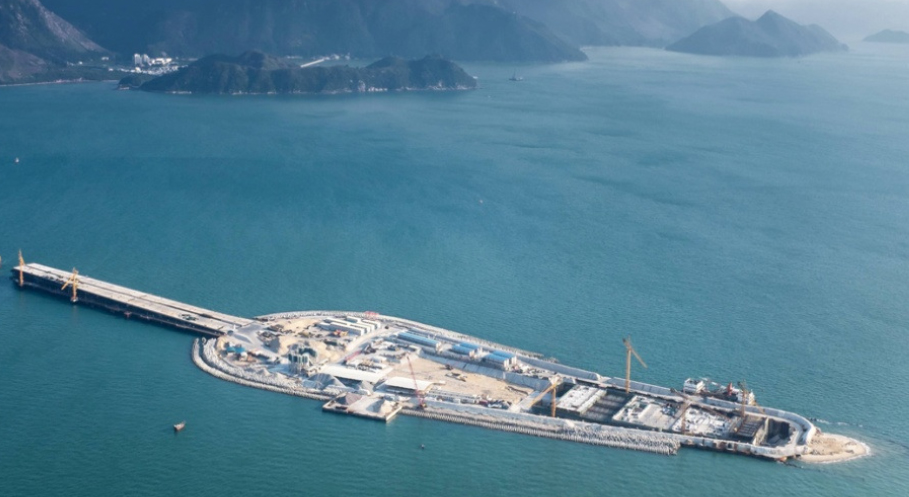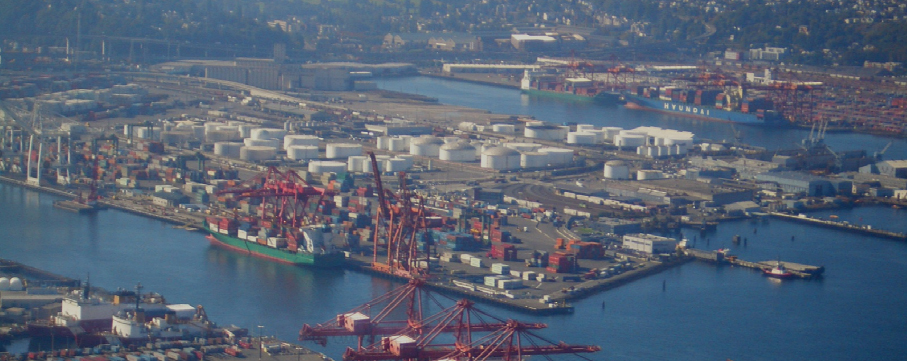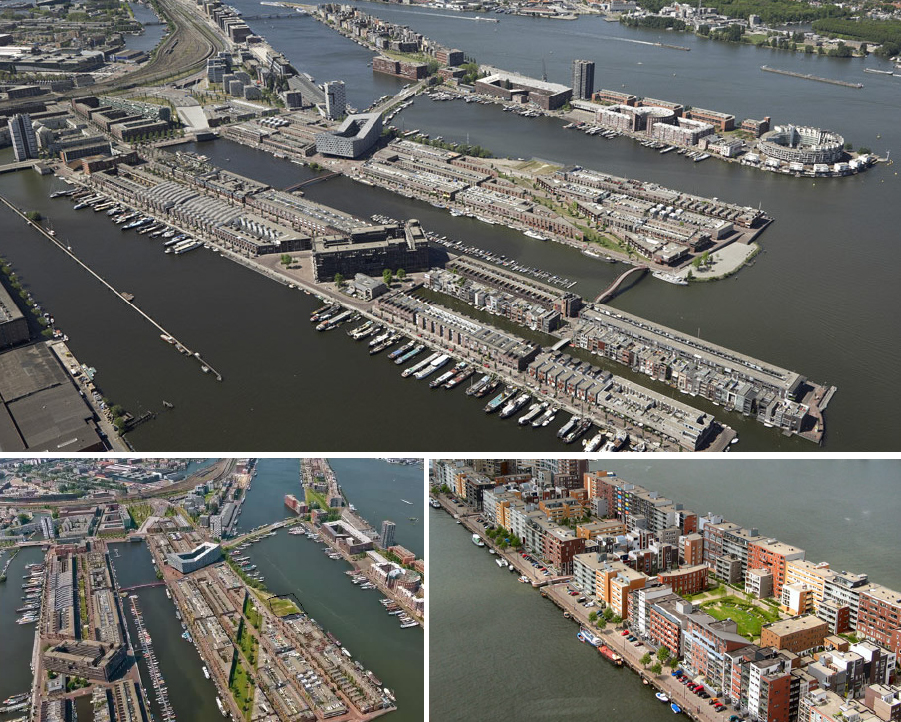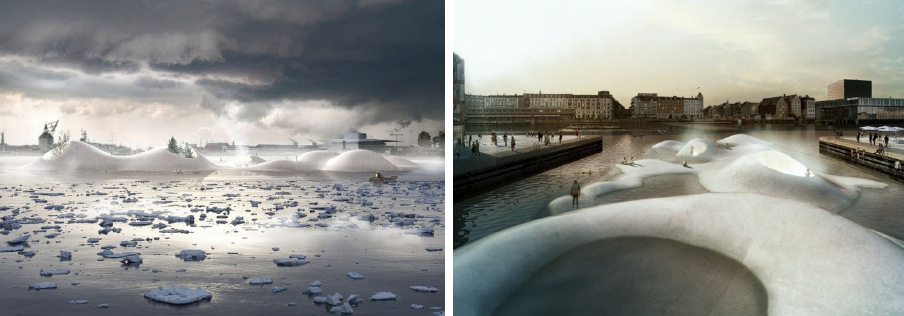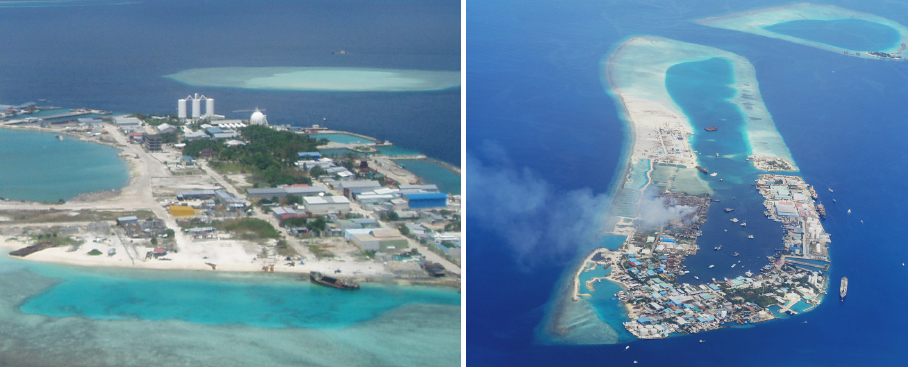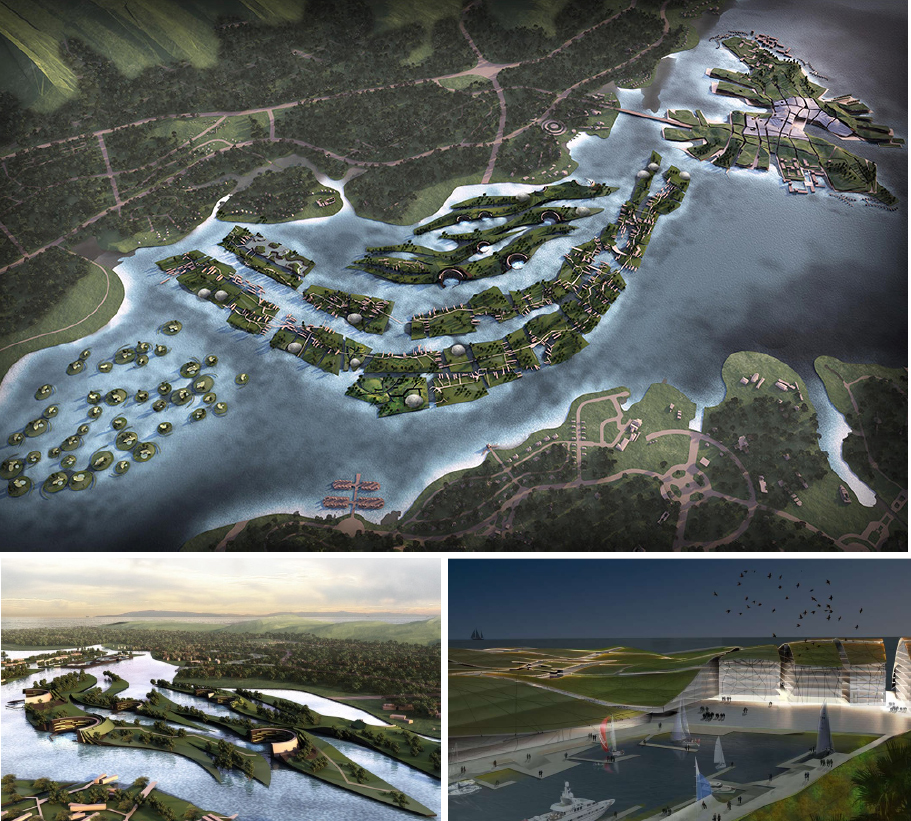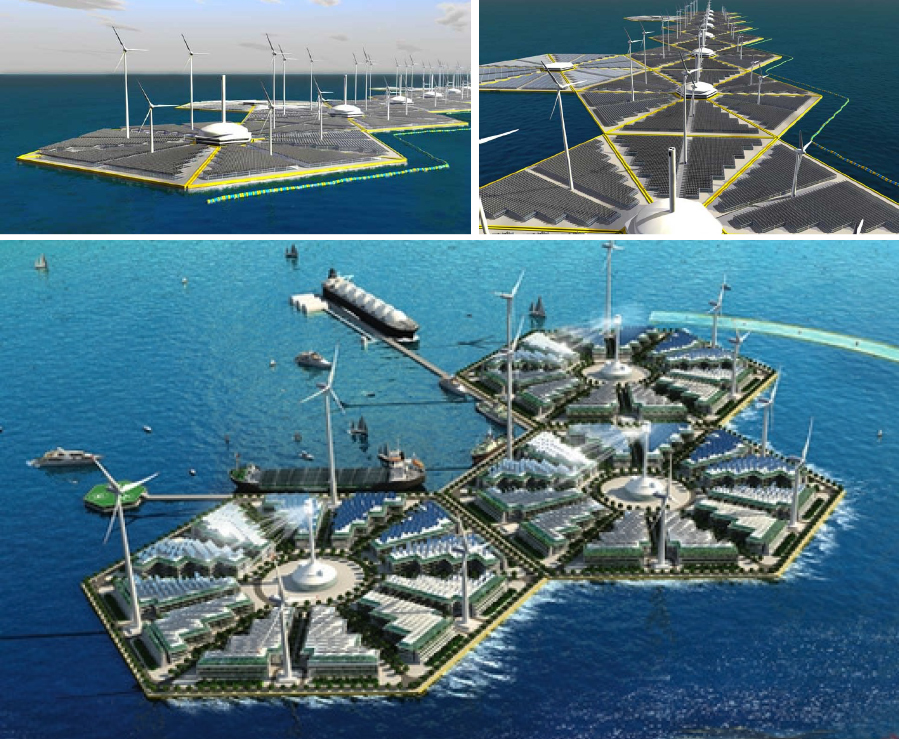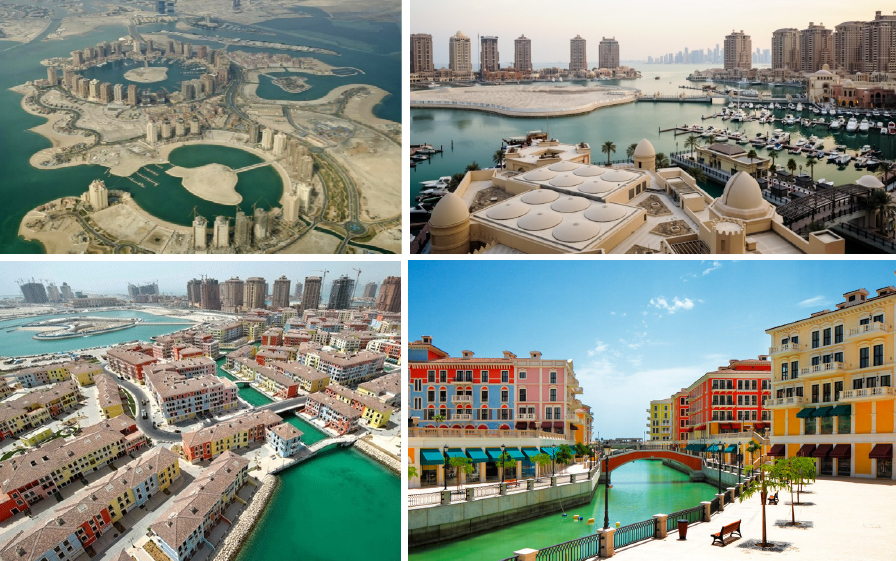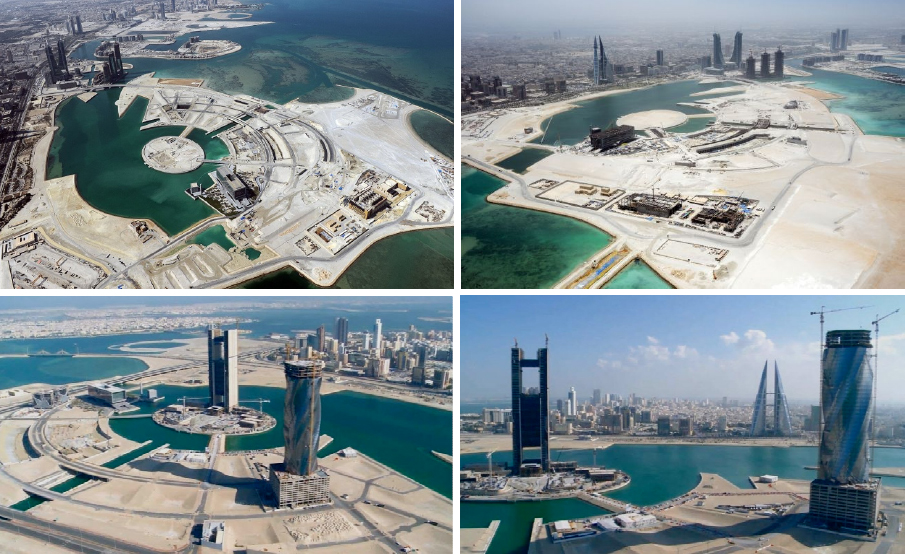The particular coastal configuration, the isolation often only apparent, the intertwining of different geographical origin cultures, the unspoiled nature and/or secular urban stratification, the rich historic-architectural heritage, the presence of particular plant and animal species are some aspects that generally characterize the islands. But they are especially suggestions and changes that the interaction between land and water produces to make extraordinary and unique the landscape of islands.
Surface lands or reclaimed areas from the sea, floating structures on the water element, the islands are part of a complex system, also from the hydrogeological point of view; along their perimeter occur different phenomena and consequently different dynamics, a complexity that increases when, as places of settlement, host the everyday life functions, in an identity that is renewed and strengthened continuously over time, among emerging and ancient realities, also in function of the interaction between natural and anthropic elements.
This short journey between land and sea wants to present some images of achievements, design interpretations, or perceptions and future visions regarding the artificial islands, seen as the product of human activity. In particular this excursion focuses on the areas created to meet the expansion needs on portions of land larger than those naturally available (Netherlands, Far East, Pacific Ocean, Indian Ocean, etc.), or to meet the needs of efficiency and functionality (international airports in Kansai and Hong Kong, offshore ports, etc.), or even to promote the development of tourism and/or luxury real estate (Dubai, Abu Dhabi, Burj Al Arab, Qatar, Bahrain, etc.). But also simply to preserve a tradition and an identity that has survived for centuries, as in the case of pre-Incan Uros tribes in Peru, who still lives on floating islands built using the reeds that grow along the waterfront of Lake Titicaca.
The implementation of infrastructure systems
As fascinating places, the islands exhibit some situations that can be considered “exceptional”, and offer diversified and unusual points of view on territories and neighboring areas; they enable to understand, better than anywhere else, the power that has water to merge or separate; the reduced spaces and short times that necessarily characterize the contexts of small extension, like these, produce in the imagination a sensation of great proximity and dynamism, while in the reality everything is often very far away and static.
While are mainly the connections and infrastructure to design spaces and times that separate an island from the mainland, are the same islands (especially the artificial ones) to make available the land to be allocated to the construction of new infrastructure, sometimes built to accommodate purely urban functions or services.
Integral part of the bridge that connects Denmark and Sweden, Peberholm is a small artificial island (130 ha) overlooking the strait of Oresund that – designed for functional reasons related to the need to have a crossover point between the bridge itself and the tunnel that connects the Malmo and Copenhagen cities – is destined to become a natural oasis of particular interest with regard to biological research.
Integral part of the bridge that connects Denmark and Sweden, Peberholm is a small artificial island overlooking the strait of Oresund.
The Hong Kong-Zhuhai-Macau Bridge is a project under construction (2009-2017) which consists of a series of bridges and tunnels crossing the Lingdingyang channel that will connect Hong Kong, Macau and Zhuhai, three major cities on the Pearl River Delta in China.
The concept of this project is similar to that of the Oresund Bridge between Denmark and Sweden: an undersea tunnel that becomes integral part of the whole infrastructure in order to allow the passage at large container vessels. The whole link, which measures some 50 km in length, has been divided into several sections. The main bridge section has a length of approximately 30 km and includes 6 km immersed tunnel (approximately 40 m below the seabed) flanked by 2 artificial islands.
The Hong Kong-Zhuhai-Macau Bridge and the artificial island under construction.
Have also been realized on artificial islands, and equipped with infrastructure systems, that allow for fast and efficient links with the mainland, some of the major airports of the Asian cities: the international airport of Kansai in Osaka Bay, opened in 1994 and expanded from the 2003 to 2007, it was built to a design by Renzo Piano on two artificial islands, 3 km from the coast, and is connected to the mainland by a road and rail bridge. Built on the artificial island of Chek Lap Kok and subject of an expansion project with a vision to 2030, the international airport of Hong Kong is part of a largest program (Airport Core Programme) which involves the construction of new roads and railways, bridges, tunnels, port infrastructures and urban settlements.
The international airports of Kansai (left) and Hong Kong (right) realized on artificial islands.
It dates back to the last century the construction of Harbor Island in Seattle, made with the purpose of hosting in peripheral areas the growing industrial and commercial activities related to the port, facilitating also the goods handling and processing. The choice to transfer port activities still present in the urban fabric on new man-made structures, designed in response to market needs and latest technological innovations, concerns actually an increasing number of cases at the international level.
The Harbor Island in port of Seattle.
To suit spatial and operational requirements, you are designing for example a Offshore Port able to contribute to the growth of port realities that overlook on the Adriatic Sea, through performance comparable with those of the most advanced ports at European level; it is an innovative platform located in deep water, about 8 miles from the coast of Venice, destined to become the strength element of a larger infrastructure transformation project of strategic interest for the Italian North East.
The transfer of port activities and regeneration of brownfield sites
The meeting between land and water has always been the main factor in the birth and development of port cities, in a constant search for balance between natural elements and man-made pressures. Today that a large number of commercial and industrial areas ports are abandoned – or otherwise transferred in suburban areas where they are most extensive available surfaces – have been launched several reconversion and redevelopment projects, which internationally have returned to local communities the access to water and new functional destinations to the cities. In some of these processes the growing need of soils has led to subtract further surfaces to the sea through the creation of artificial islands.
It happened for example to the harbor area to the east of Amsterdam, where between 1874 and 1927 was even made an archipelago, whose commercial activities have been moved to the west to make way for new housing developments and spaces for public use. The masterplan Sjoerd Soeters for the redevelopment of these sites, prepared in close collaboration with the Municipal Administration, covers an area of 125,325 square meters with a total of 236,852 cubic meters of built volumes. The project (1995-2002) has provided for a fairly radical demolition of some buildings, the construction of new infrastructure (3 parallel lines, east-west) and the building of 4 transverse channels, that have allowed to create 5 more smaller islands, and 4 new very suggestive bridges. Different types of houses, numerous public places and recreational spaces were created along the waterfront.
The port areas of Amsterdam, initially abandoned and subsequently transformed to accommodate new urban functions.
Is oriented in the same direction, but is certainly most unusual, the choice to create new artificial islands also for the revitalization of the port area next to the urban center, in the not so near.
The strategic location of Copenhagen on water and the resources at its disposal are the elements from which the design studies Tredje Natur and Pk3 have redesigned the port areas with a future vision, reorganizing the city life, highlighting the nature presence, leveraging the hydraulic expertise and new technologies. The Blue Plan project is spread over 5 areas – artificial islands connected by bridges and floating paths – functionally different: the “Bird Island”, space for the research and perfect habitat for birds, insects and other animals; the “Sports Island”, reserved for water sports; the “Opera Park” devoted entirely to the music; the “House of Water” which is accessed through a traditional wooden pier; finally, the “Krøyer’s Puddle” equipped with heated swimming pools, caves and saunas, etc. In the design solution it has been given a special attention to the environment, since the Danish capital aims to become by 2025 the first city in the world with zero emissions.
For the revitalization of the port areas in the Copenhagen city, the Blue Plan project proposes the construction of 5 artificial islands connected by bridges and floating paths. (© Tredje Natur and PK3; https://tredjenatur.dk/portfolio/byrumsblik)
The environment conservation and landscape protection
As havens immersed in the waters, some islands however reserve unexpected surprises. This is the case for example of Thilafushi, an artificial island in the Maldives (7 km long and 200 meters wide), that, built to the west of Malé in proximity of a coral reef with the aim of solving the waste problem, has become a real landfill site that grows each day of about 0.92 square meters by changing its morphology. Although the World Bank launched in 2008 a specific program “Maldives Environmental Management Project”, the ecological problems not have been solved; anyway Thilafushi Island arouses a growing interest on the part of many entrepreneurs, and to date some 260 companies and a shipyard have chosen to settle on the island.
The artificial island of Thilafushi (Maldives) built to the west of Malé, in proximity of a coral reef, to solve the waste problem.
For the waste treatment New York (14 million tons per year of garbage) is focusing on the construction of 8 new artificial islands. The project, which is part of an ambitious program for the “green” redevelopment of a city with great features, aims to allocate 30% of waste in structures built on the waterfront, so as to reduce the transport costs and impacts on the environment. The Green Loop project was designed by the Present Architecture study and provides for the construction along 250 miles of the urban waterfront of some multifunctional “green islands”, for a total of 125 hectares of land, which will host specific facilities for composting and treatment in underground, and public spaces, urban parks, community gardens and didactic-educational facilities on the surface.
The Green Loop, a project conceived to solve the problem of waste treatment through building of multifunctional “green islands” along the waterfront of New York. (© PRESENT Architecture)
A particular attention, not only to the environment but also the landscape, characterizes the proposal of a new eco-city in Halong Bay, Vietnam. Able to accommodate up to 10 thousand inhabitants on a total surface of 800 hectares, the Dao Viet Eco City project – designed by TStudio of Rome, in collaboration with the Studio Majone e Transolar – he won the international competition called by the local authority Petrovietnam Premier Recreational (2011). The complex (3,350,000 square meters of built area) is a real city of water, entirely artificial, made on 5 islands, partly inspired by other innovative projects, such as Zira in Azerbaijan (Big), Dongtan in China (Arup), The Palm Island in Dubai (Nakheel Properties, Jan De Nul, Van Oord) e Masdar City in Abu Dhabi (Norman Foster, Transsolar). The architecture in the project is strongly linked to the rural landscape Vietnamese – slightly steep and terraced slopes, low buildings – to which is superimposed the urban landscape, offering advanced typological and technological solutions, anyway integrated with local construction systems. Between the ambitions of the project, expected to become a model city of the future: an alternative transportation system, devoid of cars and elaborated starting from the specific characteristics of the place; the design of the entire life cycle of buildings; the minimization of the construction and management costs; the reduction of CO2 emissions; the energy production and supply; etc.
The Dao Viet Eco City, a real city of water, entirely artificial, designed to be built on 5 islands with a particular attention to the landscape and environment. (© TStudio, Rome; https://www.tstudio.net)
An ambitious project for the production of energy from renewable sources and drinking water involves the construction of floating islands in an area between the waters of South China, Indian Ocean and Caribbean. The Energy Island, designed by architect Alex Michaelis in collaboration with the engineer Dominic Michaelis, are equipped with an electrical system able to convert the heat of tropical waters using underwater turbines that exploit the currents and wave motion. Each island, connected with the neighboring islands, is capable of producing 250 megawatts available for use in the closest residential areas, and could accommodate new agricultural land in surface, thus becoming also a structure of great tourist and ecological interest.
The Energy Island, connected in a network system and equipped with electrical systems capable of producing 250 megawatts for use in neighboring residential areas, are of great tourist and ecological interest.
The development of tourism sector and promotion of luxury real estate
Are guided instead mostly by real estate operations the ambitious projects for the construction, in particular in the United Arab Emirates, of veritable archipelagos, quite articulate and sometimes extravagant.
Unique project of its kind both qualitatively and quantitatively – so to be recognized as the eighth wonder of the world – The Palm Island (Palm Jumeirah, Palm Jebel Ali, Palm Deira) overlooks the stretch of sea facing the Dubai coast and reproduces the stylized shape of a palm tree. Within the archipelago, the Palm Jumeirah complex, connected to the mainland by a bridge of 300 m and an underwater tunnel, is the one with the highest percentage of completed interventions; on an extension of 550 hectares (100 million cubic meters of sand, 7 million tons of crushed stone, rock and gravel) and with a diameter of 5 km, it includes in fact 500 apartments, 2,000 villas, 25 hotels and 200 luxury retail spaces. Even more exclusive and in progress is the project for the World Islands, 300 islands located 400 km from the Dubai coast and articulated so as to play a globe.
On the crystal waters of the Persian Gulf, the creation of artificial islands, new cities on the waterfront, luxury tourist destinations and major centers for business is in full and continuous expansion, thanks to the particular climatic conditions and the presence of shallow water, as well as the significant financial availability. The Qatar is engaged for example in implementing the plan for the West Bay Lagoon and The Pearl Project (United Development Company) that, located 350 meters from the Doha coast and built on 4 million square meters reclaimed from the sea, will make available once completed more than 32 km of waterfront and able to accommodate 15,000 residential units and 45,000 residents.
The Pearl project, built on 4 million square meters reclaimed from the sea, will make available once completed more than 32 km of new waterfronts in Qatar.
In the realm of Bahrain, to the northeast of the Muharraq Island, the Amwaj Islands have already been created, extended artificial territories (2,790,000 square meters) where are arising new residential districts; to the south is under construction the Durrat al Bahrain, a new coastline entirely dedicated to the elite tourism, and in front of the capital Manama are being completed the Bahrain Financial Harbour and the Bahrain Bay (luxury apartments, offices, commercial spaces, and accommodation facilities, marinas, etc.).
The Amwaj Islands in the realm of Bahrain and the new projects on the artificial islands.
In the emirate of Sharjah will arise the Nujoom Islands (Al Hanoo Holding Company), a veritable floating city with residential complexes, luxury hotels, office spaces and shopping centers, while in Oman The Wave project will make available 6 km of coast near the Muscat capital.
These major projects, which in their extravagance and grandeur have a strong appeal to the international level, since many years arouse the interest not only of professionals and experts from different disciplines (urban planners, landscape architects, sociologists, etc.) but above of all real estate companies and planning offices, investors and manufacturers, to become models for replication in other contexts, even on a small scale. In Bulgaria for example, the Pomorie city would like to realize the project of a local architect, Kamen Shipkov: three new artificial islands, connected to each other and the mainland by a bridge of 260 meters, on which settle 5-7 star hotels, a marina (700 berths for yachts), a casino, an aquarium, entertainment parks, swimming pools and spa complex, then a luxury tourist destination.
Revive the tourism and transform some places in unique destinations for elites is the aim which also pursues the city of Malacca in Malaysia, where it is planned to create three artificial islands over an area of 609 acres. The Melaka Gateway (ferries wheel, shopping street with international brands, marina and nautical facilities, Gateway Beacon Tower high 268 square meters, hotels, luxury residences) is part of a larger project oriented to the development of high quality tourism products, which should be completed predictably in 2025 and on which the Malaysia Government is committed with the goal of reaching 36 million tourists by 2020.
The Melaka Gateway, made in Malaysia on three artificial islands to revive the elite tourism.
Among the most popular tourist destinations, built on an artificial island in Urayasu (Chiba) in Japan, the Tokyo Disneyland is a theme park known internationally for the surprising originality of its attractions and spectacular water features, a veritable resort which recently reopened its doors to the public after the disastrous Tōhoku earthquake in 2011.
The Tokyo Disneyland, a theme park between the most popular tourist destinations, built on an artificial island in Urayasu (Japan).
It was designed by Erick van Egeraat the mini-archipelago of Federation Islands that should have been realized in the Black Sea, off the resort city of Sochi, to host the events organized on the occasion of the 2014 Winter Olympics. The complex – connected to the mainland by two road tunnel, a pedestrian walkway and a maritime terminal – would contain residences, hotels, cultural attractions and recreational facilities, as well as hosting the manifestations related to the event.
The former Portuguese colony of Macao (China), 60 km south-west of Hong Kong, has only 310 meters of land border with Guangdong, but than 41 kilometers of coastline overlooking the Pearl River Delta. The impressive remediation and dredging interventions carried over time have transformed what was originally an island into a peninsula 10 times its initial size, where the production and business activities have been gradually replaced by the industry of entertainment (fairs, shows, concerts, art exhibitions, etc.) and gambling, thus attracting large number of tourists and making the region an offshore financial center, a free port with no control regimes and a tax haven.
Head image: The Palm Jumeirah complex (550 hectares) realized in Dubai and connected to the mainland by a bridge of 300 m and an underwater tunnel.
Arcipelaghi e isole artificiali. Gestire il presente, immaginare il futuro
La particolare conformazione costiera, l’isolamento spesso solo apparente, l’intreccio di culture di diversa provenienza geografica, la natura incontaminata e/o la secolare stratificazione urbana, il ricco patrimonio storico-architettonico, la presenza di particolari specie animali e vegetali sono alcuni degli aspetti che generalmente caratterizzano le isole. Ma sono in particolare le suggestioni e le variazioni che l’interazione tra terra e acqua produce a rendere il paesaggio delle isole straordinario e unico.
Terre emerse o superfici sottratte al mare, strutture galleggianti nell’elemento acqua, le isole sono parte di sistema complesso, anche dal punto di vista idrogeologico, lungo il cui perimetro si attestano differenti fenomeni e di conseguenza diverse dinamiche; una complessità che cresce nel momento in cui, come luoghi di insediamento, accolgono le funzioni del vivere quotidiano, in un’identità che si rinnova e si rafforza con continuità nel tempo, tra realtà emergenti ed antiche, anche in funzione dell’interazione tra elementi naturali e antropici.
Questo breve viaggio tra terra e mare vuole restituire alcune immagini di realizzazioni, interpretazioni progettuali, o percezioni e visioni future che riguardano le isole artificiali, intese come prodotto dell’attività umana. In particolare l’excursus si sofferma sulle isole realizzate per rispondere alla necessità di espansione su porzioni di terreno più estese rispetto a quelle naturalmente disponibili (Paesi Bassi; Estremo Oriente, Oceano Pacifico, Oceano Indiano, etc.), oppure per soddisfare esigenze di efficienza e funzionalità (aeroporti internazionali del Kansai e di Hong Kong, porti offshore, etc.), o ancora per promuovere lo sviluppo turistico e/o il real estate di lusso (Dubai, Abu Dhabi, Burj Al Arab, Qatar, Bahrain, etc.). Ma anche semplicemente per conservare una tradizione e un’identità che sopravvive da secoli, come nel caso della tribù pre-inca degli Uros in Perù, che vive ancora su isole galleggianti realizzate utilizzando le canne che crescono lungo il fronte d’acqua del lago Titicaca.
La realizzazione di sistemi infrastrutturali
Luoghi di grande fascino, le isole presentano situazioni che si possono ritenere “eccezionali”; offrono punti di vista diversificati e insoliti su territori e contesti limitrofi; permettono di comprendere, meglio che altrove, il potere che effettivamente ha l’acqua di unire o di separare; gli spazi e i tempi ridotti che caratterizzano necessariamente i contesti di piccola estensione, come questi, producono nell’immaginazione una sensazione di grande prossimità e dinamicità, mentre nella realtà concreta tutto risulta spesso molto lontano e statico.
Se da un lato sono soprattutto i collegamenti e le infrastrutture a disegnare gli spazi e i tempi che separano un’isola dalla terraferma, dall’altro sono proprio le isole (in particolare quelle artificiali) a rendere disponibili superfici da destinare alla realizzazione di nuove infrastrutture, a volte costruite per accogliere anche funzioni prettamente urbane o di servizio.
Parte integrante del ponte che collega la Danimarca e la Svezia, Peberholm è una piccola isola artificiale (130 ha) affacciata sullo stretto di Oresund che, progettata per ragioni funzionali legate all’esigenza di avere un punto di crossover tra il ponte stesso e il tunnel che collega le città di Malmo e Copenhagen, è destinata a divenire un’oasi naturale di particolare interesse per quanto riguarda la ricerca in campo biologico.
Parte integrante del ponte che collega la Danimarca e la Svezia, Peberholm è una piccola isola artificiale affacciata sullo stretto di Oresund.
L’Hong Kong-Zhuhai-Macau Bridge è un progetto in corso di realizzazione (2009-2017); consiste in una serie di ponti e tunnel che attraversano il canale Lingdingyang per connettere Hong Kong, Macau e Zhuhai, tre delle maggiori città affacciate sul Pearl River Delta in Cina. Il concetto di questo progetto è simile a quello dell’Oresund Bridge tra Danimarca e Svezia: un tunnel sottomarino che diventa parte dell’intera infrastruttura per consentire il passaggio delle grandi navi portacontainer. L’intero collegamento, che misura circa 50 km di lunghezza, è stato suddiviso in diverse sezioni. La sezione principale del ponte ha approssimativamente una lunghezza di 30 km e include 6 km di tunnel sommerso (circa 40 mt sotto il livello del mare) affiancato da due isole artificiali.
L’Hong Kong-Zhuhai-Macau Bridge e l’isola artificiale in corso di costruzione.
Sono stati realizzati sempre su isole artificiali, e dotati di sistemi infrastrutturali in grado di garantire collegamenti rapidi ed efficienti con la terraferma, alcuni dei maggiori aeroporti delle città asiatiche: lo scalo internazionale del Kansai nella baia di Osaka, aperto nel 1994 e ampliato dal 2003 al 2007, è stato costruito su progetto di Renzo Piano su due isole artificiali, a 3 km dalla costa, ed è collegato alla terraferma da un ponte stradale e ferroviario. Costruito sull’isola artificiale di Chek Lap Kok e oggetto di un progetto di ampliamento con una visione al 2030, l’aeroporto internazionale di Hong Kong è parte di un programma più vasto (Airport Core Programme) che prevede la realizzazione di nuovi collegamenti stradali e ferroviari, ponti, gallerie, infrastrutture portuali e insediamenti urbani.
Gli aeroporti internazionali del Kansai (a sinistra) e di Hong Kong (a destra) realizzati su isole artificiali.
Risale al secolo scorso la costruzione di Harbor Island a Seattle, realizzata con la finalità di ospitare in aree periferiche le crescenti attività industriali e commerciali legate al porto, facilitando inoltre la movimentazione e il trattamento delle merci. La scelta di trasferire le attività portuali ancora presenti nel tessuto urbano su nuove strutture artificiali, progettate rispondendo alle esigenze del mercato e alle più recenti innovazioni tecnologiche, interessa un numero crescente di casi a livello internazionale.
Harbor Island nel porto di Seattle.
Per rispondere ad esigenze spaziali e di carattere funzionale, si progetta ad esempio un Porto Offshore in grado di contribuire alla crescita delle realtà portuali affacciate sul Mar Adriatico mediante performance comparabili con quelle dei porti più avanzati a livello europeo; si tratta di una piattaforma innovativa collocata in acque profonde a circa 8 miglia dalla costa di Venezia, destinata diventare il punto di forza di un più ampio progetto di trasformazione infrastrutturale di interesse strategico per il Nord Est italiano.
Il trasferimento delle attività portuali e il recupero delle aree dismesse
La relazione tra terra e acqua è da sempre l’elemento principale nella nascita e nello sviluppo delle città portuali, in una ricerca continua di equilibrio tra elementi naturali e pressioni antropiche. Oggi che un gran numero di porti commerciali e ambiti industriali risultano dismessi – o comunque trasferiti nelle periferie urbane dove risultano più estese le superfici disponibili – sono stati avviati diversi progetti di riconversione e riqualificazione, che a livello internazionale hanno restituito alle collettività locali l’accesso all’acqua e nuove destinazioni funzionali alla città. In alcuni di questi processi la necessità crescente di suolo ha indotto a sottratte ulteriori superfici al mare attraverso la realizzazione di isole artificiali.
È accaduto ad esempio per il porto ad est di Amsterdam, dove tra il 1874 e il 1927 è stato realizzato addirittura un arcipelago, le cui attività mercantili sono state spostate verso occidente per lasciare spazio a nuovi insediamenti residenziali e spazi ad uso pubblico. Il masterplan di Sjoerd Soeters per la riqualificazione di queste aree, elaborato in stretta collaborazione con l’Amministrazione Comunale, interessa una superficie di 125.325 mq per un totale di 236.852 mc di volumi edificati. Il progetto (1995-2002) ha previsto una demolizione piuttosto radicale di alcuni edifici, la realizzazione di nuove infrastrutture (3 direttrici parallele est-ovest) e la costruzione di 4 canali trasversali, che hanno consentito di creare altre 5 isole minori, e 4 nuovi ponti molto suggestivi. Diverse tipologie abitative, numerosi spazi pubblici e spazi ricreativi sono stati realizzati lungo il fronte d’acqua.
Le aree portuali di Amsterdam inizialmente dismesse e successivamente riqualificate per accogliere nuove funzioni urbane.
È orientata nella stessa direzione, ma senza dubbio più insolita, la scelta di realizzare nuove isole artificiali anche per la rivitalizzazione di aree portuali prossime al centro urbano, in un futuro non tanto prossimo.
La posizione strategica di Copenhagen sull’acqua e le risorse di cui dispone sono gli elementi a partire dai quali gli studi di progettazione Tredje Natur e Pk3 hanno ridisegnato le aree portuali in una visione futura, riorganizzando la vita della città, valorizzando la presenza della natura, sfruttando le competenze in campo idraulico e le nuove tecnologie. Il progetto Blue Plan si sviluppa su 5 aree – isole artificiali collegate tramite ponti e percorsi galleggianti – funzionalmente differenti: la “Bird Island”, spazio destinato alla ricerca e l’habitat perfetto per uccelli, insetti e altri animali; la “Sports Island” riservata invece agli sport acquatici; l”Opera Park” interamente dedicata alla musica; l”House of Water” a cui si accede tramite un molo in legno tradizionale; infine, la “Krøyer’s Puddle” dotata di piscine riscaldate, grotte e saune, etc. Nella soluzione progettuale è stata prestata un’attenzione particolare all’ambiente, in quanto la capitale danese si propone di diventare entro il 2025 la prima città al mondo ad emissioni zero.
Per la rivitalizzazione delle aree portuali nella città di Copenhagen il progetto Blue Plan propone la realizzazione di 5 isole artificiali collegate tramite ponti e percorsi galleggianti. (© Tredje Natur e PK3; https://tredjenatur.dk/portfolio/byrumsblik)
La conservazione dell’ambiente e la tutela del paesaggio
Oasi immerse nelle acque, alcune isole riservano tuttavia sorprese inaspettate. È il caso ad esempio dell’isola artificiale di Thilafushi nelle Maldive (7 km di lunghezza e 200 mt di larghezza) che, costruita ad ovest di Malé in prossimità di una barriera corallina con la finalità di risolvere il problema dei rifiuti, è divenuta una vera e propria discarica che cresce ogni giorno di circa 0,92 mq modificando la sua morfologia. Pur avendo la Banca Mondiale lanciato nel 2008 un programma specifico “Maldives Environmental Management Project”, non sono ancora stati risolti i problemi ecologici; l’isola di Thilafushi suscita comunque un interesse sempre maggiore da parte di numerosi imprenditori, e ad oggi circa 260 aziende e un cantiere navale hanno scelto di insediarsi sull’isola.
L’isola artificiale di Thilafushi (Maldive) costruita ad ovest di Malé, in prossimità di una barriera corallina, per risolvere il problema dei rifiuti.
Per il trattamento dei rifiuti la città di New York (14 milioni di tonnellate annue di rifiuti) punta invece sulla costruzione di 8 nuove isole artificiali. Il progetto, che rientra in un ambizioso programma di riqualificazione “verde” della città dalle molteplici potenzialità, ha la finalità di destinare il 30% dei rifiuti a strutture realizzate sul fronte d’acqua, in modo da ridurre i costi di trasporto e gli impatti sull’ambiente. Il progetto Green Loop è stato ideato dallo studio Present Architecture e prevede la costruzione lungo le 250 miglia del waterfront urbano di alcune “isole verdi” multifunzionali, per un totale di 125 ettari di aree, che ospiteranno nel sottosuolo impianti di compostaggio e di trattamento specifici, e sulla superficie spazi pubblici e parchi, orti comuni e strutture didattico-educative.
Il Green Loop, progetto ideato per risolvere il problema del trattamento dei rifiuti mediante la costruzione di “isole verdi” multifunzionali lungo il waterfront di New York. (© PRESENT Architecture)
Una particolare attenzione non solo all’ambiente, ma anche al paesaggio, caratterizza la proposta di una nuova eco-città nella Baia di Halong in Vietnam. In grado di accogliere fino a 10mila abitanti su una superficie complessiva di 800 ettari, il progetto Dao Viet Eco City – firmato da TStudio di Roma, in collaborazione con lo Studio Majone e Transolar – ha vinto la competizione internazionale indetta dall’autorità locale Petrovietnam Premier Recreational (2011). Il complesso (3.350.000 mq di superficie costruita) è una vera e propria città d’acqua interamente artificiale realizzata su 5 isole, in parte ispirata ad altri progetti innovativi, quali ad esempio Zira in Azerbaijan (Big), Dongtan in Cina (Arup), The Palm Island a Dubai (Nakheel Properties, Jan De Nul, Van Oord) e Masdar City ad Abu Dhabi (Norman Foster, Transsolar). L’architettura nel progetto è fortemente legata al paesaggio rurale vietnamita – pendii lievemente scoscesi e terrazzati, edifici bassi – al quale viene sovrapposto il paesaggio urbano, proponendo soluzioni tipologiche e tecnologiche avanzate, comunque integrate ai sistemi costruttivi locali. Tra le ambizioni del progetto, destinato a diventare un modello di città del futuro: un sistema di mobilità alternativa, senza automobili, studiato a partire dalle caratteristiche del luogo; la progettazione dell’intero ciclo di vita degli edifici; la minimizzazione dei costi di cantiere e di gestione; la riduzione delle emissioni di CO2; la produzione e l’approvvigionamento energetico; etc.
La Dao Viet Eco City, una vera e propria città d’acqua, interamente artificiale, progettata per essere realizzata su 5 isole con una particolare attenzione al paesaggio e all’ambiente (© TStudio, Roma; https://www.tstudio.net)
Un ambizioso progetto per la produzione di energia da fonti rinnovabili e di acqua potabile prevede la costruzione di isole galleggianti in un’area compresa tra le acque della Cina Meridionale, l’Oceano Indiano e i Caraibi. Le Energy Island, disegnate dall’architetto Alex Michaelis in collaborazione con l’ingegnere Dominic Michaelis, sono dotate di un impianto elettrico in grado di convertire il calore delle acque tropicali mediante turbine sottomarine che sfruttano le correnti e il moto ondoso. Ogni isola, collegabile con le isole limitrofe, è in grado di produrre 250 megawatt disponibili per l’utilizzo nei quartieri residenziali più prossimi, e potrebbe ospitare in superficie nuovi terreni agricoli diventando così anche una struttura di grande interesse turistico-ecologico.
Le Energy Island, collegabili in un sistema a rete e dotate di impianti elettrici in grado di produrre 250 megawatt per l’utilizzo nei quartieri residenziali limitrofi, sono di grande interesse turistico-ecologico.
Lo sviluppo del settore turistico e la promozione del real estate di lusso
Guidati per lo più da operazioni di carattere immobiliare sono invece gli ambiziosi progetti per la realizzazione, in particolare negli Emirati Arabi Uniti, di veri e propri arcipelaghi piuttosto articolati e a volte stravaganti.
Progetto unico nel suo genere dal punto di vista qualitativo e quantitativo – tanto da essere riconosciuto come l’ottava meraviglia del mondo – The Palm Island (Palm Jumeirah, Palm Jebel Ali, Palm Deira) si affaccia sul tratto di mare prospiciente la costa di Dubai e riproduce la forma stilizzata di una palma. All’interno dell’arcipelago il complesso di Palm Jumeirah, collegato alla terraferma da un ponte di 300 m e da un tunnel sottomarino, è quello con la maggior percentuale di interventi ultimati; su un ‘estensione di 550 ettari (100 milioni di metri cubi di sabbia, 7 milioni di tonnellate di pietrisco, roccia e ghiaia) e con un diametro di 5 km, accoglie infatti 500 appartamenti, 2.000 ville, 25 hotel e 200 spazi commerciali di lusso. Ancora più esclusivo e in corso di realizzazione è il progetto per le World Islands, 300 isole situate a 400 km dalla costa di Dubai e articolate in modo da riprodurre un mappamondo.
Sulle acque cristalline del Golfo Persico la creazione di isole artificiali, di nuove città sul waterfront, di mete turistiche di lusso e di grandi centri per affari è in piena e continua espansione, grazie anche alle particolari condizioni climatiche e alla presenza di acque poco profonde, nonché alla consistente disponibilità finanziaria. Il Qatar è impegnato ad esempio nella realizzazione del piano per la West Bay Lagoon e del progetto The Pearl (United Development Company) che, situato a 350 mt dalla costa di Doha e costruito su 4 milioni di mq sottratti al mare, renderà disponibili una volta completato più di 32 km di fronti d’acqua e sarà in grado di accogliere 15.000 unità residenziali e 45.000 abitanti.
Il progetto The Pearl, costruito su 4 milioni di mq sottratti al mare, renderà disponibili una volta completato più di 32 km di nuovi fronti d’acqua in Qatar.
Nel regno del Bahrain, a nord-est della Muharraq Island, sono già sorte le Amwaj Islands, estesi territori artificiali (2.790.000 mq) su cui stanno sorgendo nuovi quartieri residenziali; a sud è in fase di costruzione il Durrat al Bahrain, un nuovo litorale interamente dedicato al turismo d’elite, e di fronte alla capitale Manama sono in fase di completamento il Bahrain Financial Harbour e il Bahrain Bay (appartamenti di lusso, uffici, spazi commerciali, hotel e strutture ricettive, porti turistici, etc.).
Le Amwaj Islands nel regno del Bahrain e i nuovi progetti sulle isole artificiali.
Nell’emirato di Sharjah sorgeranno le Nujoom Islands (Al Hanoo Holding Company), una vera e propri città sull’acqua con complessi residenziali, hotel di lusso, spazi direzionali e centri commerciali, mentre in Oman il progetto The Wave renderà disponibili 6 km di litorale presso la capitale Muscat.
Questi grandi progetti, che nella loro stravaganza e maestosità hanno un forte appeal a livello internazionale, da diversi anni suscitano l’interesse non solo di professionisti ed esperti appartenenti a diversi campi disciplinari (urbanisti, paesaggisti, sociologi, etc.) ma soprattutto di società immobiliari, studi di progettazione, investitori e costruttori, fino a diventare modelli da riproporre in altri contesti, anche su piccola scala. In Bulgaria ad esempio la città di Pomorie vorrebbe realizzare il progetto di un architetto locale, Kamen Shipkov: tre nuove isole artificiali, collegate tra loro e con la terraferma mediante un ponte di 260 mt, su cui insediare hotel 5-7 stelle, un porto turistico (700 posti per yacht), un casinò, un acquario, parchi per il divertimento, piscine e complessi termali, quindi una destinazione turistica di lusso.
Rilanciare il turismo e trasformare alcuni luoghi in destinazioni uniche per élite è la finalità che persegue anche la città di Malacca, in Malesia, dove è prevista la creazione di tre isole artificiali su una superficie di 609 acri. Il Melaka Gateway (ruota panoramica, via dello shopping con firme internazionali, marina e strutture per la nautica, Gateway Beacon Tower alta 268 mt, hotel, residenze di lusso) rientra in realtà in un progetto più ampio orientato allo sviluppo di prodotti turistici di alto livello, che dovrebbe essere completato prevedibilmente nel 2025 e su cui il Governo della Malasia è impegnato con l’obiettivo di raggiungere i 36 milioni di turisti entro il 2020.
Il Melaka Gateway, realizzato in Malesia su tre isole artificiali per rilanciare il turismo di élite.
Tra le mete turistiche più ambite, realizzato su un’isola artificiale a Urayasu (Chiba) in Giappone, il Tokyo Disneyland è un parco a tema noto a livello internazionale per la sorprendente originalità delle sue attrazioni e gli spettacolari giochi d’acqua, un vero e proprio resort che ha recentemente riaperto le sue porte al pubblico, dopo il disastroso terremoto del Tōhoku nel 2011.
Il Tokyo Disneyland, parco a tema tra le mete turistiche più ambite, realizzato su un’isola artificiale a Urayasu (Giappone).
È stato disegnato da Erick van Egeraat il mini-arcipelago di Federation Islands che avrebbe dovuto essere realizzato nel Mar Nero, al largo della città turistica di Sochi, per ospitare gli eventi organizzati in occasione delle Olimpiadi Invernali del 2014. Il complesso – collegato alla terraferma mediante due tunnel stradali, una passerella pedonale e un terminal marittimo – avrebbe dovuto contenere residence, hotel, attrazioni culturali e strutture ricreative, oltre ad ospitare le manifestazioni legate all’evento.
L’ex colonia portoghese di Macao (Repubblica Popolare Cinese), 60 km a sud-ovest di Hong Kong, possiede solo 310 metri di confine terrestre con Guangdong, ma ben 41 chilometri di costa affacciati sul delta del fiume delle Perle. Gli imponenti interventi di bonifica e i dragaggi effettuati nel tempo hanno trasformato quella che originariamente era un’isola in una penisola 10 volte la sue dimensioni iniziali, dove le attività produttive e commerciali sono state progressivamente sostituite dall’industria dell’intrattenimento (fiere, spettacoli, concerti, esposizioni artistiche, etc.) e del gioco d’azzardo, attirando così grandi flussi turistici e rendendo la regione un centro finanziario offshore, un porto franco privo di regimi di controllo e un paradiso fiscale.
Head image: Il complesso di Palm Jumeirah (550 ettari), realizzato a Dubai e collegato alla terraferma da un ponte di 300 m e da un tunnel sottomarino.

